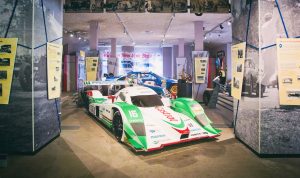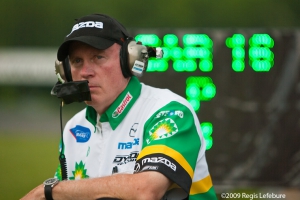BASILDON, ESSEX May 22, 2014 – Advanced Engine Research celebrated their fifteenth anniversary in 2013. Their project codes started at 01 in 1998 and are now at 90. Since their founding, they have worked on over 50 engine related projects. Last year showcased their strengths in engineering services and clean sheet engine design:
• GP3 Series: engine design, manufacture and track support for 27 cars in the 16- race series.
• Designed and built a new LMP1 V-6 gasoline direct injection twin-turbo engine for the 2014 ACO LMP1 regulations, the only bespoke non-manufacturer backed LMP1 engine.
• Upgraded their 2013 ALMS LMP1 turbocharged 2.0 litre four-cylinder engine to gasoline direct injection.
• Chosen to design, supply and support the engines for the 2015 Indy Lights Series.
The GP3 Series was looking for an engine that had more power, torque and efficiency than what they had been using, plus they wanted an engine that lasted a full season. AER provided a 400 horsepower all-aluminium 3.4 litre naturally aspirated V-6. Featuring drive by wire, it is a fully stressed engine designed to go a full season without servicing. There were no engine failures in 2013, giving the engine 432 successful race finishes.
The first conceptual work on the P60 2014 LMP1 engine began in 2011 when the ACO announced that the 2014 technical regulations would be based on allocating a quantity of energy to each car with a fuel flow allocation. AER modeled half a dozen different engine configurations before choosing the V-6 GDI twin-turbo, building on their success in applying GDI to their four-cylinder American Le Mans Series LMP1 engine. GDI’s benefits work well with the new regulations’ emphasis on brake-specific fuel consumption.
The P90 four-cylinder turbocharged 2.0 litre ALMS LMP1 engine with GDI made its race debut at Lime Rock Park in Connecticut in July 2013 with Dyson Racing, and ran fault-free the remainder of the ALMS season. Providing increased power, drivability, and efficiency, the GDI system was initially designed for a Formula One engine supplier as part of a development project of a 1.6 litre four-cylinder engine as a test bed for the originally proposed 2014 Formula One regulations.
And in November of 2013, Andersen Promotions announced that AER would supply engines to the Indy Lights Series starting in 2015. The Indy Lights P63 is a new version of AER’s turbocharged four-cylinder 2.0 litre sports car engine. The four-year deal will feature an engine designed to run a full season without maintenance. The fully stressed engine will have a “push to pass” feature which will be good for fifty additional horsepower. The engine has been detuned to 450 horsepower and at 97 kilos, is very light weight with a low center of gravity.
“We had many highlights in 2013, but one of the biggest was the success of the GP3 engine. We had no engine failures all year,” noted Mike Lancaster, Managing Director of AER. “A lot of effort went into producing and servicing the powerful and reliable engines for the series and race teams. At the same time, we were working solidly on the 2014 P60 ACO LMP1 engine and it was good to get that running before the end of the year. The introduction of the ALMS LMP1 P90 engine with GDI was another highlight of the year along with the contributions that engine made to the design of the P60 engine.
“And 2014 is even busier. We are excited about our new bespoke ACO LMP1 engine built to their new fuel flow regulations. Kodewa has signed on for the FIA World Endurance Championship with their Lotus-branded chassis plus we are talking to other teams. We are very excited about this project. We have an extensive history in international sportscar competition and we always look forward to running competitively at endurance racing’s most iconic events.
“We are continuing the GP3 program and it is rewarding for AER to be part of a feeder series ultimately leading to Formula One. 2014 marks the second year of our three-year contract to supply engines and provide track support.
“We are also immersed in the 2015 P63 Indy Lights engine. We are working closely with Dallara on installation positions for the turbo, exhaust manifold and bell housing. We are looking at having test engines mid-summer which will then go to Dallara in Italy with a shakedown in Italy and then testing back in the states in late summer with the first batch of engines available at the end of the year.
“Plus we continue to work on a number of OEM projects and Life Racing is busy with the electronics for all the AER engines, in addition to their defense and aerospace work. With all this on our plate, we are expanding and we are in the process of moving into another building that will double our size and give us a much larger engine build capacity, a bigger machine shop and allow us to add the necessary people to continue engineering and building our engines and provide proper customer care. This is an exciting chapter in our history as we look ahead to the future.”



